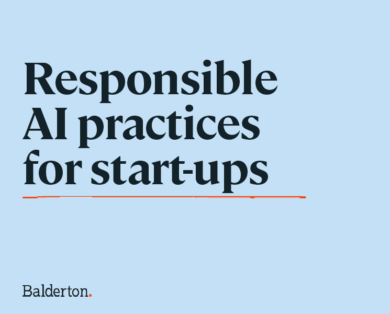- 09 April, 2025
How to build fast moving cross-functional product teams
This article is brought to you by Balderton’s Executives-In-Residence, Thor Mitchell and Dan Teodosiu.
A key strength of high performing cross-functional product teams is that they make decisions fast. It’s common for leaders to assume that teams are moving slowly because they are understaffed or underperforming. But often the constraint is not the rate at which the team can generate code, but their decision making ability.
In this article we review the main factors that inhibit decision making by teams, and the actions you can take, as a founder, CEO, or senior leader, to enable your teams to make well informed decisions quickly.
1. A culture that lacks empowerment or urgency
For teams to maintain velocity, they must feel trusted to make decisions with no sense of personal threat.
Without trust, teams will feel required to escalate every decision, and justify every recommendation with data and research. Without psychological safety, teams will not make decisions until they have total confidence in them. They will instead move slowly as they over invest in validation, or try to defer decisions to another team or to a framework.
As a leader, you must therefore offer opportunities for teams to earn trust by proactively delegating decisions, requiring a recommendation with all escalated decisions, and pushing back on decisions that did not need to be escalated. Teams should be encouraged to draw on their expertise and product instincts in order to maintain pace, and also encouraged to take informed risks, particularly for low risk and easily reversible decisions.
However, while ensuring teams feel safe making decisions quickly it’s important that you preserve a sense of urgency and accountability. A considerate team culture is invaluable but can result in teams that feel no pressure to act quickly or judiciously, because pressuring others to be decisive, or challenging their decisions, is seen as aggressive and culturally unacceptable.
Actions to take: Make rapid decision making a cultural value
- Clearly signal that teams are expected to make decisions as the experts in their domain, and have permission to do so. Require teams that do escalate a decision to provide a recommendation, and push back on teams that unnecessarily escalate a decision. “I trust you to make this decision” is an incredibly powerful phrase.
- Create a psychologically safe environment in which your teams feel free to make decisions without fear of personal consequences if they do not work out.
- Cultivate due urgency within the business, in which rapid decision is recognised and rewarded. Do not tolerate unnecessary delays in decision making. Reinforce that a “good enough” decision today is better than a perfect decision tomorrow.
2. A lack of alignment
Teams can only build trust if they can make decisions that their leadership respects. That is only possible if the leadership provides a clear product vision and strategy to align behind, a set of product principles to guide decision making, and any current business context that may impact the sensitivity or risk of decisions to be made.
The leadership must also consistently reinforce the product vision, strategy, and principles through their own decision making. This enables teams to correctly anticipate their position, and avoids delays due to team decisions being challenged by the leadership.
If the leadership is not aligned, teams will be forced to speculate on how they will react to decisions. Worse still, conflicting guidance will flow downwards through the organisation, forcing teams to spend time reconciling contradictory information, and requiring decisions to be escalated for clarification.
Actions to take: Build strong alignment at every level
- Craft and distribute a clear and compelling product vision, strategy, and principles, and proactively share current business context with product teams at all times.
- Invest heavily in communicating the product vision, strategy, and principles, reinforcing them at every opportunity to ensure that every member of your team understands and is guided by them when making decisions.
- Empower your teams to anticipate your position and avoid any risk that they receive confusing messages, by ensuring that decisions made by the leadership are consistent with the product vision, principles, and business context.
3. Excessive gatekeeping
Decision making at scale requires that most decisions are delegated to the teams. Leaders may resist this because they do not trust teams to make good decisions, want to stay “in the details”, or enjoy “calling the shots”. This inevitably reduces the speed and quality of decision making, because leaders lack the time or context to make good decisions quickly.
Decisions also take time to be escalated, either because teams must escalate one level at a time, securing buy-in at every stage, or because decisions must be brought to a stakeholder review, which is difficult to schedule and time consuming to prepare for.
Such reviews may not even reach a decision if the culture demands consensus. This is common in the early days of a startup, and can feel culturally healthy, but over time becomes unsustainable. The number of stakeholders becomes overwhelming, a single dissenting voice can obstruct a decision, and a single absent stakeholder can reopen a decision later.
This can be further exacerbated if the organisation suffers from “best practice dogmatism”, in which stakeholders demand that every decision be supported by unnecessarily detailed and time consuming customer research, data gathering, or testing.
Stakeholder reviews eventually become “consensus theatre”. Decisions are postponed if total agreement is not immediately evident, and team members learn that they must meet with each stakeholder individually before the review to secure their support.
Actions to take: Remove barriers to decision making
- Limit the need for “blocking approvals” to the absolute minimum. Adopt a “trust and inform” model, where teams are expected to share decisions they have made, but do not pause for assent.
- Limit your involvement in decision making to only those decisions that are high risk or highly strategic. Tolerate differing opinions to your own on inconsequential topics, and resist the temptation to insert yourself into decisions.
- Limit the number of people who have the right of veto in a decision. Allow people to have a voice, but do not require consensus. If necessary, adopt and enforce a framework such as RACI to identify the roles of individuals in a decision.
- Empower teams to rely on their experience and intuition when making decisions. Limit the need for research and testing to only cases where the optimal choice is hard to predict, and sufficiently strategic to justify the time required.
- Call out overpreparation for internal discussions. Reward scrappy demos, rough sketches, and draft documents over beautiful slide decks and pixel perfect mockups.
4. Organisational inertia
For teams to maintain a high pace of delivery, the key decision makers must be “high agency” people with the bias-to-action, confidence, and competence needed to make good decisions quickly, and must also not be hindered by poor organisational design.
For example, if a team’s work has a lot of cross-team dependencies, it will be challenging for them to make planning decisions without extensive negotiations on a shared roadmap. Similarly if the stakeholders for a team are very dispersed across time zones, it will take a day or more to solicit even trivial feedback, iterate on a proposal, or gather approvals.
Teams may also rely too heavily on one person to make decisions. For example, an engineering team might defer to the Product Manager on all planning decisions, or require that a Design lead sign off on every pixel that changes. When that person is unavailable or unresponsive, this can paralyse the team.
Actions to take: Build an organisation of decision makers
- Staff your teams with high agency people with a bias-to-action and a desire to win. Ensure that they thrive in a rapidly changing business environment, are comfortable dealing with ambiguity, and are able to make decisions with limited data.
- Limit cross-team or cross-timezone dependencies as much as possible to maximise autonomy within teams.
- Develop cross functional skills within teams (e.g. “product minded” engineers), to create resilience within the teams if a critical function is unavailable.
5. Operational constraints
It can become hard for the leadership to keep track of all of the work in progress as the number of teams increase. Leaders often respond by adding processes for planning, status updates, and release management. These add structure and discipline, but also create significant “work about work”, with heavyweight approval chains that teams must navigate.
Accessing product data can also become difficult, limiting the ability of teams to make data informed decisions. The infrastructure and tooling required may not be in place, access to the data may be restricted to a small and overloaded team of data analysts, or team members may not have the skills needed to service their own data needs.
Similarly, as technical debt accrues, teams may find themselves building on unstable, hard to understand, or antiquated technology. Every product decision then becomes high risk because the behaviour of the system is unpredictable and prone to failure. Each change must be carefully planned, staged, tested, and rolled out. As a consequence, decisions that should be trivial to make become complex, contentious, and time consuming.
Actions to take: Make investments that support decision making
- Push back against process creep and excessive internal bureaucracy. Be aware of the hidden cost of “work about work”, and limit the baggage of decision making.
- Invest in your data pipeline from early in your startup journey, and put in place the tooling needed to enable teams to serve their own data needs.
- Allow teams to manage their technical debt to ensure that maintaining and evolving your product does not carry excessive levels of risk.
Conclusion
As you can see, the issues identified above stem from a failure of leadership, rather than a failure of teams to execute. It is therefore essential that as a leader you recognise your role in enabling rapid decision making, and embrace the responsibility to build the culture, trust, and discipline that your teams need to operate at speed.
 Thor Mitchell
Thor Mitchell 










